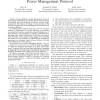Free Online Productivity Tools
i2Speak
i2Symbol
i2OCR
iTex2Img
iWeb2Print
iWeb2Shot
i2Type
iPdf2Split
iPdf2Merge
i2Bopomofo
i2Arabic
i2Style
i2Image
i2PDF
iLatex2Rtf
Sci2ools
ICNP
2006
IEEE
2006
IEEE
O-MAC: A Receiver Centric Power Management Protocol
— Energy efficiency is widely understood to be one of the dominant considerations for Wireless Sensor Networks. Based on historical data and technology trends, the receiver energy consumption will dominate all energy, to the point that for the majority of applications, power management research must focus on receiver efficiency. By modeling several popular MAC layer protocols, we derive bounds on performance for receiver efficiency. In particular, we analyze four abstract models, Synchronous Blinking (e.g. TMAC, S-MAC), Long Preamble (e.g. B-MAC), Structured TimeSpreading (also called Asynchronous Wake-Up), and Random Time Spreading. These results strongly suggest that scheduling the receiver so as to minimize (or eliminate) the potential for interference (or collisions) could be from 10 fold to 100 fold more efficient than current practice. We provide two new receiver scheduling methods, Staggered On and Pseudorandom Staggered On, both of which are designed to exploit the untapp...
| Added | 11 Jun 2010 |
| Updated | 11 Jun 2010 |
| Type | Conference |
| Year | 2006 |
| Where | ICNP |
| Authors | Hui Cao, Ken Parker, Anish Arora |
Comments (0)

